
Today, I am sharing my recipe for Blueberry and Grand Marnier Jam! Blueberry and orange are a great flavor combo so why not add a little kick to the jam by adding an orange-flavored liqueur. This does add a level of richness and flavor complexity to the jam.

This recipe has been developed specifically using highbush blueberries which are quick and easy to pick. No need to get down on the hands and knees to pick these blueberries!
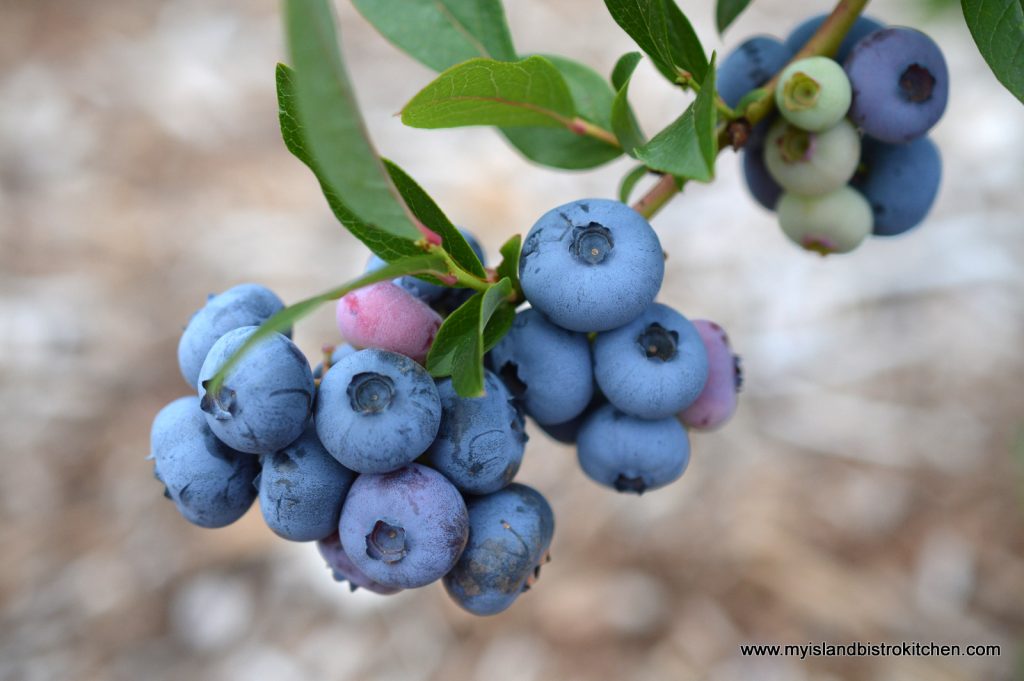
It takes very few minutes to pick a 5-pound box or bowlful.
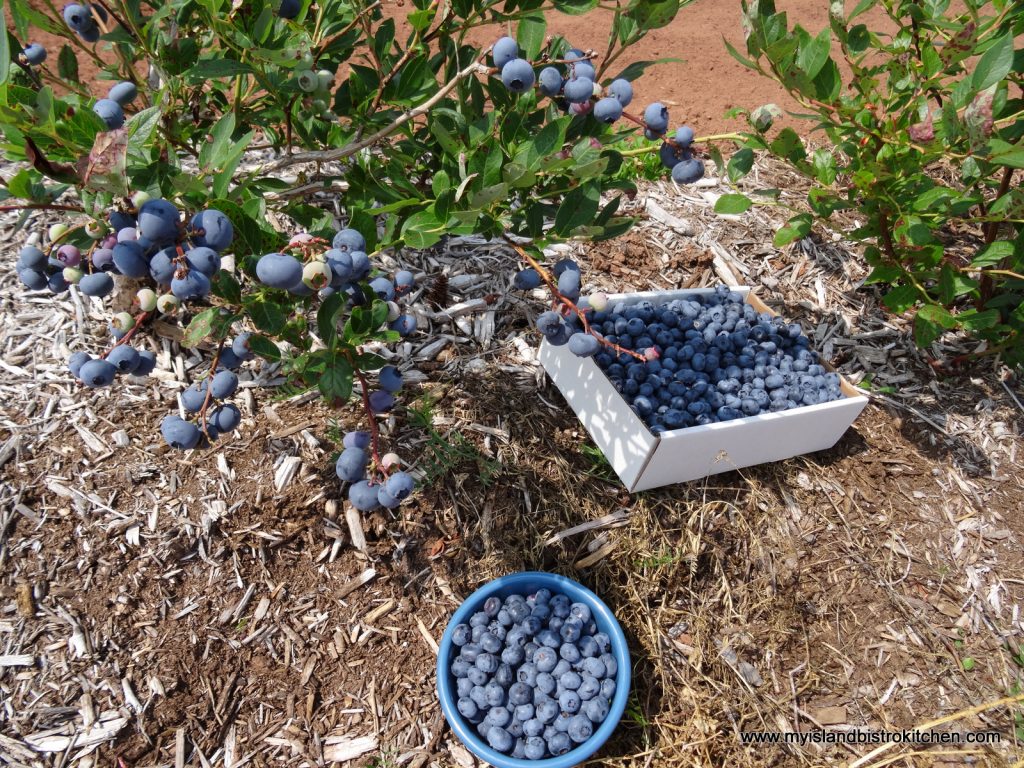
I do use liquid pectin in the jam which gives it a soft set. I find blueberry jam takes forever to cook and thicken if I don’t use pectin. This is still a soft consistency jam that spreads easily and it is jam packed full of summer flavor!
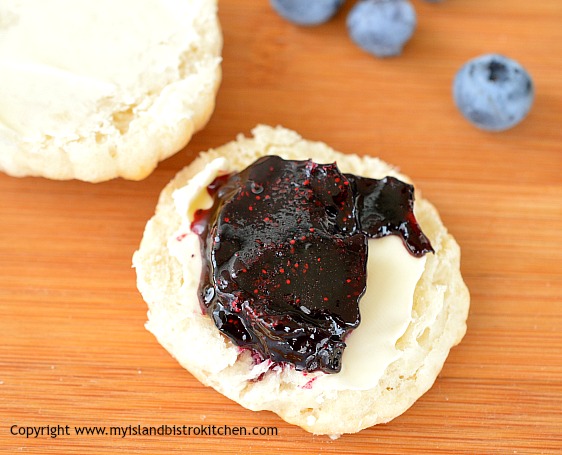
The berries need to be slightly crushed so that their juices get released quickly as this jam does not cook long. Only crush a few berries at a time, using a potato masher, and make sure they are in single layers as you crush them so that each berry gets broken open. There is no need to purée them as the idea is for the jam to still have some texture to it and not be completely smooth like a jelly.
Adding a bit of cinnamon, nutmeg, and lemon rind provides an additional flavor boost to the jam.
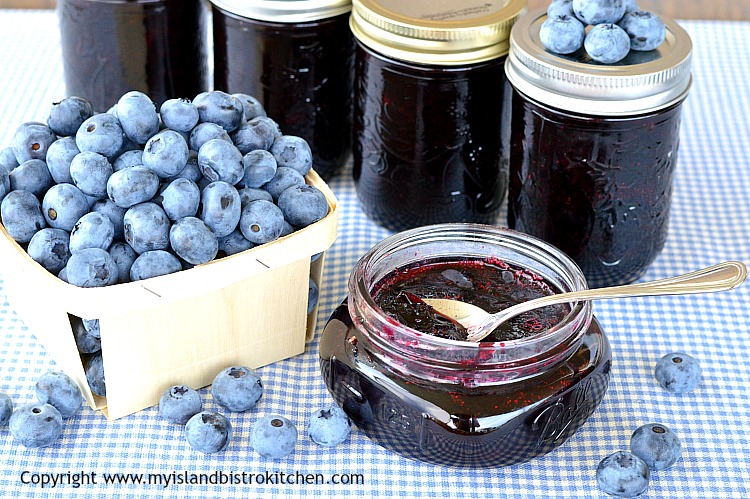
This jam is especially good on biscuits, scones, and toast. It’s also quite delightful dolloped on top of custard or Greek yogurt for a simple and quick dessert.

But, first, before making this delicious jam, here are some tips for successful jam-making.
TIPS FOR SUCCESSFUL JAM MAKING
Get Organized
I know it’s exciting to find a new recipe for a jam and it’s tempting to just go headfirst into making it but it pays to take the extra time to first get organized. The first step is to read and re-read the recipe to ensure complete understanding of the process and that you have all the necessary ingredients and equipment.
The second step in organization is to assemble all equipment and ingredients needed for the jam-making and canning processes. A list of equipment and utensils needed to make the jam can be found further down in this post.
The third step is to start the bottle sterilization process and heating the water for the hot water canner before beginning to make the jam.
Follow the Recipe Exactly – No Substituting, Omitting, or Reducing of Ingredients
For success, follow the recipe exactly, without substituting, omitting, or reducing amounts of ingredients (unless an ingredient is listed as “optional”). Each ingredient contributes something valuable to the finished product. For example, it is well-known that jam recipes call for a lot of sugar. Some will ask if they can significantly reduce the amount of sugar called for in a recipe and the simple answer is, no, not without potentially affecting the gelling properties of the jam and sacrificing the quality and preservative functions of the jam. Apart from the sweetness sugar imparts on jam, it also acts as a preservative, protecting the jam against the development of bacteria, yeast, and mold. It, along with the hot water processing of the jam, is what will help make the jam shelf stable for several months.
The addition of lemon juice, in most important terms, helps the natural pectin found in the fruit to gel or set properly. The acidic properties of the lemon juice also balance out the sweetness of the jam, add flavor notes, and brightens the color of the jam. Bottled lemon juice (as opposed to freshly squeezed lemon juice) is preferred by many jam makers because its acidity level is regulated and thus consistent. This is in contrast to fresh lemons that vary in quality and ripeness.
This recipe was developed specifically for the use of highbush blueberries. These are the large plump blueberries that grow on high bushes as opposed to the small wild blueberries that grow close to the ground. Use of wild blueberries in this particular recipe is not recommended as they are a different category of berry and vary greatly in size and weight.
Fresh blueberries are recommended for this recipe as frozen berries tend to have accrued excess moisture in and around them which may cause issues and interfere with the jam gelling process.
Use Only Proper Canning Jars for Jam
Ensure that proper canning jars, approved for hot water processing, are used for the jam. These are bottles such as Mason or Ball brand jars that are made of specially tempered glass capable of withstanding heat that will be necessary in the hot water canner for safe home canning of products. The glass jars have a wide mouth top and consist of a two-part lid and screw band. Exercise caution purchasing jars, that look very much like canning jars, at places like discount stores or thrift/second hand shops as they may not, in fact, be tempered glass suitable for canning.
While our ancestors may have used just any old bottles they had at their disposal, using recycled bottles from store-bought products like pasta sauce or bought pickles, for example, is not recommended for food safe home canning. First, these jars, having already been sealed by the manufacturer and the seals having been broken by the consumer to reveal the jar contents, no longer have proper sealing covers considered safe for home canning of products. Second, the bottles are generally made of glass not as thick as proper canning jars and, therefore, are not considered to be resistant to heat extremes. This means they could shatter or explode when placed in the hot water canner.
With the potential for so many air- and food-borne illnesses to occur today and with the changing conditions in which our foods are grown (or modified), along with the fact that most homes today do not have dedicated temperature-controlled cold rooms (or cold cellars like many of our ancestors had) in which to store home canned goods, it is all the more reason why both the proper canning jars and home canning procedures are an essential component to jam making. Do not skip the proper bottle sterilization and hot water canning processes.
Sterilizing the Jars
There are various methods for sterilizing the bottles for the jam. I use the traditional method of sterilizing the jars in hot water as I can better control the timing of having the hot jars ready at the express moment the jam is ready for bottling. The jars must be hot when they are filled with the jam as they will be immediately going into the hot water canner of boiling water and cold jars are likely to crack.
Approximately seven (7) half-pint sized glass canning jars will be required for this recipe. Begin by inspecting each jar before using it to ensure there are no chips or cracks.
Since this jam involves a quick cooking process, you will want to get the jar sterilization process underway before you start cooking the jam. This is because, once the jam is bottled, it needs to immediately go into the hot water canner. The filled jars must not be allowed to cool before being hot water processed.
Wash the jars in hot soapy water. Rinse well and drain jars. Fill a large-sized pot (fitted with a wire rack to keep the jars up off the bottom of the pot), capable of holding at least 7-10 half-pint jars upright, about two-thirds full of hot tap water. Use two large pots for this process, if necessary.
Do not stack jars, one on top of another. Place the jars, upright and in single layer, into the water. Ensure the jars are fully submerged, each jar filled with water, and that the water is at least an inch over the tops of the jars, adding more if necessary. Cover, bring to a boil, and boil gently for 10 minutes. Turn off heat and leave the jars in the hot water to have ready to fill once the jam is ready.
Because so many factors can determine exactly how many jars will be needed to accommodate the jam, I recommend having at least one to two extra jars sanitized in case they are needed. Even if they aren’t needed to be filled with jam, the hot empty jars may be needed to fill up space in the hot water canner if it is not completely filled to capacity with jars containing the jam. This is to ensure that the filled jars do not topple over during the hot water processing.
To protect your countertop from the hot wet bottles and jam drippings, use a heatproof cutting board covered with newspaper to protect the board. Set a wire rack on top of the board.
Lids and Screw Bands/Rings
The metal lids for the canning jars are only single use and are NEVER to be reused for canning food. Always, always use new lids for each canning session. The lids are inexpensive so don’t risk re-using them. Once you finish a bottle of jam, turf the lid.
While, historically, the lids (with the orange-rust colored gasket on their underside) were preheated in simmering hot water for 1-2 minutes to soften the lid gasket before applying the lids to the hot jars, Bernardin® (the company that manufactures canning lids available here in Canada) is now saying that preheating their own particular brand of lids is no longer necessary to provide a proper seal as the sealing compound they use in their lid manufacturing performs better at room temperature. They recommend washing the lids in hot soapy water, rinsing them, and setting the lids aside until needed in the canning process.
Note this pertains specifically to the Bernardin® brand of lids. Other manufacturers’ lids may differ so, if you are using another brand of lids, do check the manufacturer’s instructions with respect to heating lids (or not) for their particular brand lids. Typically, if the lids need to be preheated, the method is simply to place the lids in a small pan of simmering hot water over low heat just long enough to heat the rubber piece. This won’t take longer than a minute or two at most. Do not boil the lids.
The screw bands, on the other hand, can be re-used so long as they don’t have any rust spots on them or any dents.
Filling the Jars with Jam
When the jam is ready to be bottled, use a jar lifter to remove the hot sanitized jars from the water and carefully empty out the hot water back into the stock pot. Drain jars well and transfer them to the wire rack on the heatproof board. Do be very careful as this is scalding hot water.
Use a heatproof glass measuring cup or ladle to scoop up the jam and transfer it into the hot sterilized jars. A wide-mouthed funnel is useful for this process. Fill the jars, leaving about ¼″ headroom in each.
Remove any air bubbles that may appear in the jars by inserting a chopstick or small heat-proof spatula into each bottle and gently move the jam to remove any pockets of air that may have formed. Add more jam, if necessary, to bring the jam up to ¼“ from jar rim.
Make sure the rims of the filled jars have been wiped with a damp clean cloth to remove any jam residue. Even a small drop of it may prevent the lids from sealing properly and keeping out harmful bacteria that could cause the jam to spoil or someone to become ill from consuming it.
Center the washed and rinsed lids on jars so the sealing compound on the lid edges aligns with the jar rims. Once the jars have been filled with jam, fingertip tighten ring/screw bands on jars until resistance is encountered. Do not over-tighten.
Hot Water Processing of Filled Jam Jars
The jars of hot jam need to be processed in a hot water bath immediately after they have been filled with jam to ensure that any microorganisms are destroyed and the jam is shelf-stable for several months.
At its most basic, home canning of jam is the process of heating the hot sealed jars of jam in a canner of boiling water to destroy microorganisms that can cause the jar contents to spoil or people to become ill from consuming the contents contained in the jars. The process of hot water canning also gives, in this case the jam, shelf stability over several months. Note that hot water processing times vary according to the altitude of the area in which you live and, of course, the size of jars used. The processing time indicated in this recipe are for altitudes up to 1000 ft (305 m).
As mentioned above, with the potential for so many air- and food-borne illnesses to occur today and with the changing conditions in which our foods are grown (or modified) and stored in homes, proper home canning procedures are an essential component to safe jam making. Do not skip the proper hot water canning process for this jam.
Canners come in different sizes and depths to accommodate different sizes of jars. The canner must have the capacity to hold jars the size called for in a recipe and allow for boiling water to cover the jars by 1″ when they are placed in the canner basket inside the canner. Here in Canada, hot water canners are relatively inexpensive and can usually be found at stores like Walmart, hardware stores (e.g., Home Hardware and Canadian Tire) as well as some large supermarkets and other places.
For any one wishing to learn more about home canning, there are a number of reputable and reliable sources of information available on the current proper methods of canning. Books on the topic are available at libraries, bookstores, and online. The internet is also a good place to start your research but do ensure you consult reputable sites. I find a lot of university extension department websites contain good information on proper home canning procedures as do canning jar and lid manufacturing sites.
Before beginning to make the jam, fill the canner about one-half full of hot tap water and, over medium-high heat, bring it to the boiling stage to have ready when the jam is finished and ready for its hot water bath. Reduce heat to keep the water hot while the jam is being made.
It’s also a good idea to get a kettle of boiling water ready in case extra is needed to top up the canner after the filled jars are added. The hot jars of jam need to immediately go into the hot water bath so, after the jam is bottled, there will be no time then to start boiling the canner water which can take a significant period of time.
Note that I recommend adding 1 to 2 extra half-pint jars to the pot with those being sterilized for the jam. While they may not be needed to fill with jam, they may be needed (depending on the canner size and design) to fill up extra space in the canner basket so those jars filled with jam do not topple over in the hot water process. Most canner baskets will hold 6 – 7 half-pint jars and, if a batch of jam has less quantity than that, the bottles will fall over unless the basket is filled with bottles.
This particular batch of jam should yield approximately 7 half-pint jars but a lot depends on the quality of the berries and it is difficult to say with exact assurance the precise quantity of jam a recipe will yield. For this reason, I do recommend having 1-2 extra jars ready to fill up the canner space, if they are needed. While the empty jars for this purpose do not need to be sanitized, they must be hot going into the boiling water in the canner as, otherwise, the temperature change could cause cold jars to crack when they are submerged into the boiling water. The easiest way I find to heat them is to simply put them in the pot with the jars being sterilized.
Using jar lifter tongs, carefully place filled jars upright and in a single layer in the wire basket or rack positioned in the canner, ensuring jars do not touch each other or fall over. If a canner is not completely full to capacity of filled jars, add one or more hot empty jars, upright, to the basket to fill up space so the filled jars do not topple over during processing. Should this be necessary, let the empty jars fill with water from the canner as they are submerged so they will stay upright as the canner water boils.
Ensure the water level is at least 1” above the tops of jars, adding more boiling water as necessary. When it gets to this stage in the process, I recommend having a kettle of boiled water already available if it is needed to top up the canner water levels.
Cover the canner with its lid. Increase the heat to return the water to a full rolling boil then decrease the heat to just keep the water at a moderately rolling boil but not boiling over. Process the half pint jars in the hot water bath for 10 minutes, adjusting time as and if necessary for altitude. Start timing the processing from the point at which a full rolling boil is reached after jars have been added to the canner. At the end of the processing time, turn off heat and remove canner lid.
Let jars sit in the hot water for 5 minutes then, using jar lifter tongs, carefully remove the jars filled with jam, one at a time, upright, and transfer them to a heat-proof cutting board, that has been covered with a towel to protect it, to cool completely. Listen for the “pop” or “ping” sound as the bottles seal over the next few minutes or hours. The lids of properly sealed jars will curve downward.
Check Processed Jars for Proper Sealing
Let jars rest, undisturbed, and covered with a towel to keep light out, on counter for 24 hours. Then, test each jar for proper sealing by lightly pressing down on the center of each jar lid. If the lid is already pressed downward, and does not pop back up, it is properly sealed. Any jars that do not pass this test should be refrigerated and the jam used within a week or so.
Storing Jam
Store properly sealed jam bottles in cool, dark place and let rest for at least 1 -2 weeks before opening to allow flavors to develop. Refrigerate jam once jar has been opened. Use jam within one year of bottling.
Blueberry and Grand Marnier Jam
Supplies and Equipment Needed:
7 half-pint glass canning jars for the jam (plus 1 – 2 more half-pint-sized jars to take up extra space in the canner basket, if needed, during the hot water process)
7 – two-piece lid and screw band sets (lids must be brand new and NOT previously used)
Heat-proof cutting board(s) and wire rack for sitting hot jars on
Medium-sized, heavy-bottomed, stock pot for jam
Large-sized pot fitted with wire rack for sterilizing jars
Potato Masher for crushing/breaking down berries
Bowl for crushing berries
Large, heat-proof spoon for stirring jam
Water bath canner with basket
Jar lifter tongs
Wide-mouthed canning funnel
Ladle or heat-proof glass measuring cup
Chopstick or small non-metallic heat-proof spatula to remove any air bubbles/air pockets from filled jars
A timer
Clean cloth for wiping jar rims of jam-filled jars
Ingredients:
4 cups crushed fresh high bush blueberries (apx. 2 lbs)
3¼ cups granulated sugar
½ tsp cinnamon
¼ tsp nutmeg
1 tsp finely grated lemon rind
2 tbsp bottled lemon juice
1 – 85ml pouch Certo liquid pectin
¼ cup Grand Marnier liqueur
Method:
Wash canning jars and lids in hot soapy water. Rinse. Drain.
Fill a large-sized stockpot about two-thirds full of hot tap water. Fit stockpot with wire rack. Place the jars, on the rack, upright and in single layer, into the water. Use more than one stockpot if necessary to accommodate all jars needed for the recipe. Do not stack jars on top of each other in stockpot. Ensure the jars are fully submerged, each jar filled with water, and that the water is at least an inch over the tops of the jars, adding more if necessary. Cover, bring to a boil over medium-high heat, then reduce heat slightly and boil gently for 10 minutes. Turn off heat and leave the jars in the hot water to have ready to fill once the jam is ready.
Fill the hot water canner about half full of hot tap water. Cover and bring to a boil over medium-high heat to have it ready for processing of the filled jars. Reduce heat to keep canner water hot.
Wash the berries. Lightly roll berries in a tea towel to dry them. Place 1 cup of berries in a bowl and, using a potato masher, lightly crush berries to release their juice. Transfer to a medium-sized stockpot. Repeat with remaining berries, lightly crushing one cup at a time.
In bowl, mix sugar and spices together. Stir in lemon rind.
Add the sugar-spice mixture and lemon juice to the blueberries. Stir well and bring to a full rolling boil over medium to medium-high heat, stirring to prevent scorching. Once boiling, boil hard for 1 minute, stirring continuously. Remove from heat and add the pouch of liquid pectin along with the Grand Marnier liqueur. Stir for 5 minutes, skimming off any foam that may form.
Boil a kettle of water to have ready, if needed, to top up water levels in the canner once the filled jars are added.
Use jar lifter tongs to carefully remove the hot sterilized jars from the water, one at a time, emptying the water from the jars back into the pot. Drain jars well and place on heat-proof board. Do be very careful as this is scalding hot water.
Using a ladle, or a heat-proof glass measuring cup, and a wide-mouthed canning funnel, fill the hot sterilized jars with the jam, leaving about ¼” headroom in each jar to allow for expansion during the hot water processing. Remove any trapped air bubbles in the jars with a chopstick or small heatproof spatula. Add more jam to jars, if necessary, to bring jam up to ¼“ from jar rims. Wipe the jar rims with a clean damp cloth to remove any stickiness that could prevent the lids from sealing properly to the jars.
Center the lids on jars so the sealing compound on the lid edges aligns with the jar rims. Fingertip tighten the ring/screw bands until resistance is encountered. Do not over-tighten.
Using jar lifter tongs, carefully place filled jars upright in wire basket positioned in the canner, ensuring jars do not touch each other or fall over. If a canner is not completely full of filled jars, add enough hot empty jars to fill it to capacity to prevent filled jars from toppling over during processing. Make sure the empty jars are already hot as cold jars immersed in boiling hot water are likely to crack. Let the empty jars fill with water from the canner as they are submerged.
Ensure the water level is at least 1” above the tops of jars, adding more boiling water as necessary. Cover with canner lid. Increase the heat to return the water to a full rolling boil then decrease the heat to just keep the water at a moderately rolling boil but not boiling over. Process jars in the hot water bath for 10 minutes, adjusting time as and if necessary for altitude. Start timing the processing from the point at which a full rolling boil is reached after jars have been added to the canner. At the end of the processing time, turn off heat and remove canner lid.
Let jars sit in the hot water for 5 minutes then, using jar lifter tongs, carefully remove the jars filled with jam, one at a time, upright, and transfer them to a heat-proof cutting board, that has been covered with a towel, to cool completely. Listen for the “pop” or “ping” sound as the bottles seal over the next few minutes or hours. The lids of properly sealed jars will curve downward.
Cover jars with a towel to keep light out and let jars rest, undisturbed, on counter for 24 hours. Then, test each jar for proper sealing by lightly pressing down on the center of each jar lid. If the lid is already pressed downward, and does not pop back up, it is properly sealed. Any jars that do not pass this test should be refrigerated and the jam used within a week or so.
Store properly sealed jam bottles in cool, dark place and allow to rest for at least 1-2 weeks to allow flavor to fully develop before opening. Use jam within one year of bottling. Refrigerate jam once jar has been opened.
Yield: Apx. 7 half-pint jars
If you have made this recipe and enjoyed it and/or wish to share it with your friends and family, please do so on social media but be sure to share the direct link to this posting from my website.
Connect with My Island Bistro Kitchen on Social Media
Join the Facebook page for My Island Bistro Kitchen: https://www.facebook.com/MyIslandBistroKitchen/
Follow “the Bistro” on “X” (formerly Twitter): https://twitter.com/PEIBistro/
See the drool-worthy gallery of mouth-watering food photos from My Island Bistro Kitchen on Instagram: https://www.instagram.com/peibistro/
Follow “the Bistro” on Pinterest at https://www.pinterest.ca/peibistro/ and pin the Pinterest-ready photo at the end of this posting to your favorite Pinterest boards!
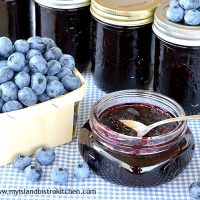
Blueberry and Grand Marnier Jam
Ingredients
- 4 cups crushed fresh (not frozen) highbush blueberries (apx. 2 lbs)
- 3¼ cups granulated sugar
- ½ tsp cinnamon
- ¼ tsp nutmeg
- 1 tsp finely grated lemon rind
- 2 tbsp bottled lemon juice
- 1 – 85ml pouch Certo liquid pectin
- ¼ cup Grand Marnier liqueur
Instructions
- Wash canning jars and lids in hot soapy water. Rinse. Drain.
- Fill a large-sized stockpot about two-thirds full of hot tap water. Fit stockpot with wire rack. Place the jars, on the rack, upright and in single layer, into the water. Use more than one stockpot if necessary to accommodate all jars needed for the recipe. Do not stack jars on top of each other in stockpot. Ensure the jars are fully submerged, each jar filled with water, and that the water is at least an inch over the tops of the jars, adding more if necessary. Cover, bring to a boil over medium-high heat, then reduce heat slightly and boil gently for 10 minutes. Turn off heat and leave the jars in the hot water to have ready to fill once the jam is ready.
- Fill the hot water canner about half full of hot tap water. Cover and bring to a boil over medium-high heat to have it ready for processing of the filled jars. Reduce heat to keep canner water hot.
Wash the berries. Lightly roll berries in a tea towel to dry them. Place 1 cup of berries in bowl and, using a potato masher, lightly crush berries to release their juice. Transfer crushed berries to a medium-sized stockpot. Repeat with remaining berries, lightly crushing one cup at a time.
- In bowl, mix sugar and spices together. Stir in lemon rind.
- Add the sugar-spice mixture and lemon juice to the blueberries. Stir well and bring to a full rolling boil over medium to medium-high heat, stirring to prevent scorching. Once boiling, boil hard for 1 minute, stirring continuously. Remove from heat and add the pouch of liquid pectin along with the Grand Marnier liqueur. Stir for 5 minutes, skimming off any foam that may form.
- Boil a kettle of water to have ready, if needed, to top up water levels in the canner once the filled jars are added.
- Use jar lifter tongs to carefully remove the hot sterilized jars from the water, one at a time, emptying the water from the jars back into the pot. Drain jars well and place on heat-proof board. Do be very careful as this is scalding hot water.
- Using a ladle, or a heat-proof glass measuring cup, and a wide-mouthed canning funnel, fill the hot sterilized jars with the jam, leaving about ¼” headroom in each jar to allow for expansion during the hot water processing. Remove any trapped air bubbles in the jars with a chopstick or small heatproof spatula. Add more jam to jars, if necessary, to bring jam up to ¼“ from jar rims. Wipe the jar rims with a clean damp cloth to remove any stickiness that could prevent the lids from sealing properly to the jars.
- Center the lids on jars so the sealing compound on the lid edges aligns with the jar rims. Fingertip tighten the ring/screw bands until resistance is encountered. Do not over-tighten.
- Using jar lifter tongs, carefully place filled jars upright in wire basket positioned in the canner, ensuring jars do not touch each other or fall over. If a canner is not completely full of filled jars, add enough hot empty jars to fill it to capacity to prevent filled jars from toppling over during processing. Make sure the empty jars are already hot as cold jars immersed in boiling hot water are likely to crack. Let the empty jars fill with water from the canner as they are submerged.
- Ensure the water level is at least 1” above the tops of jars, adding more boiling water as necessary. Cover with canner lid. Increase the heat to return the water to a full rolling boil then decrease the heat to just keep the water at a moderately rolling boil but not boiling over. Process jars in the hot water bath for 10 minutes, adjusting time as and if necessary for altitude. Start timing the processing from the point at which a full rolling boil is reached after jars have been added to the canner. At the end of the processing time, turn off heat and remove canner lid.
- Let jars sit in the hot water for 5 minutes then, using jar lifter tongs, carefully remove the jars filled with jam, one at a time, upright, and transfer them to a heat-proof cutting board, that has been covered with a towel, to cool completely. Listen for the “pop” or “ping” sound as the bottles seal over the next few minutes or hours. The lids of properly sealed jars will curve downward.
- Cover jars with a towel to keep light out and let jars rest, undisturbed, on counter for 24 hours. Then, test each jar for proper sealing by lightly pressing down on the center of each jar lid. If the lid is already pressed downward, and does not pop back up, it is properly sealed. Any jars that do not pass this test should be refrigerated and the jam used within a week or so.
Store properly sealed jam bottles in cool, dark place and allow to rest for at least 1-2 weeks to allow flavor to fully develop before opening. Use jam within one year of bottling. Refrigerate jam once jar has been opened.
Recipe Notes
Yield: Apx. 7 half-pint jars
[Copyright My Island Bistro Kitchen]
You may also enjoy these other tasty jam, marmalade, and jelly recipes from My Island Bistro Kitchen:
Jams
Small Batch Cherry Jam
Strawberry-Rhubarb Freezer Jam
Blueberry and Grand Marnier Jam
Gooseberry Jam
Zucchini Jam
Pumpkin Jam
Traditional Raspberry Jam (no pectin added)
Marmalades
Rhubarb Marmalade
Green Tomato Marmalade
Peach Marmalade
Jelly
Strawberry-Rhubarb Jelly
Rosy Rhubarb Jelly
Crabapple Jelly
Pin Me To Pinterest!
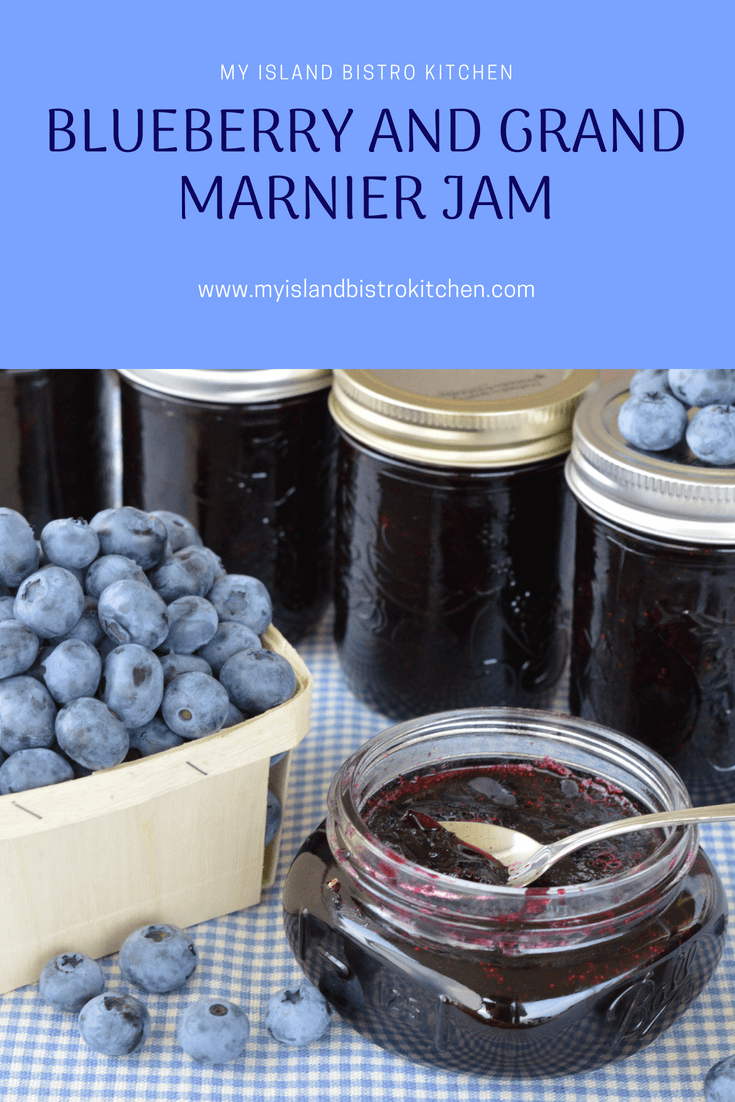
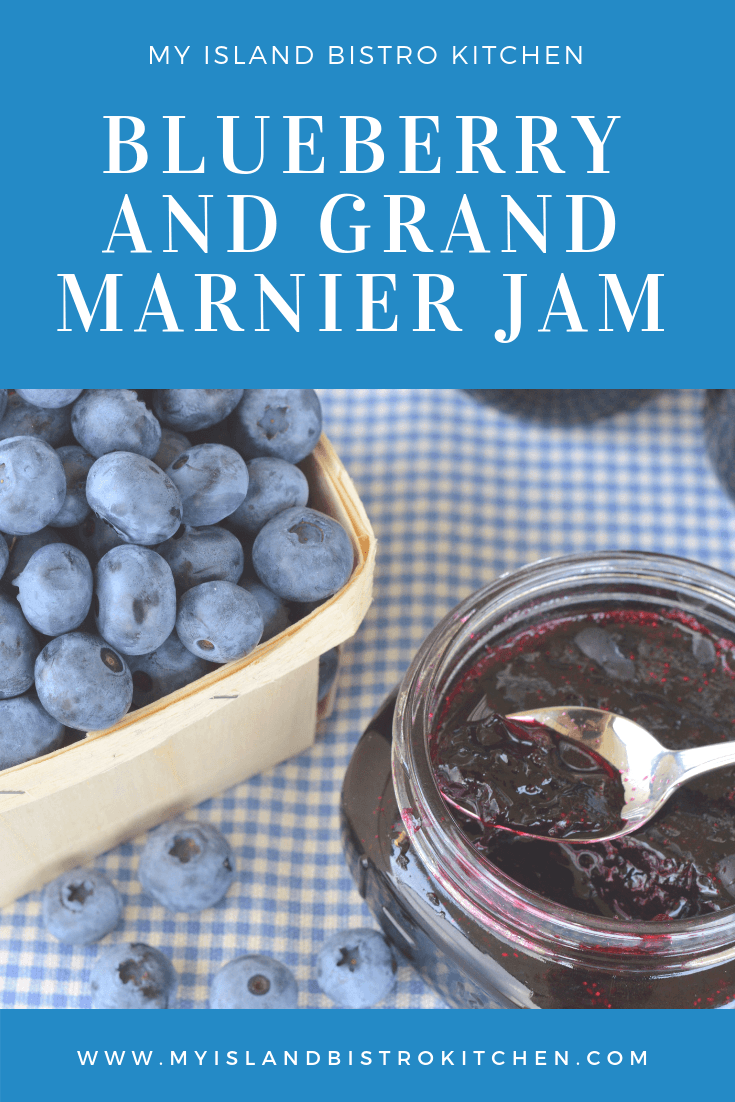
[This post and recipe were last updated on August 23, 2024]


